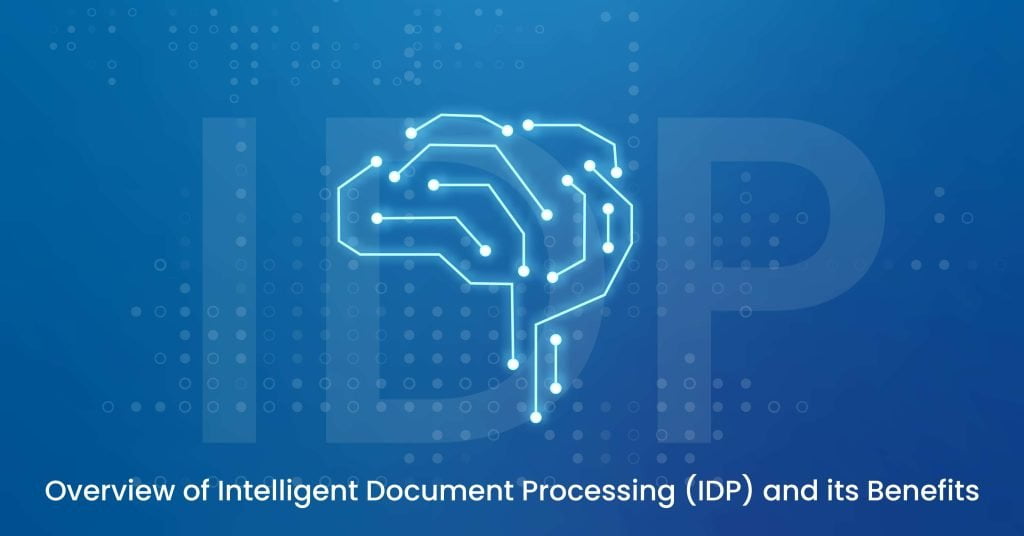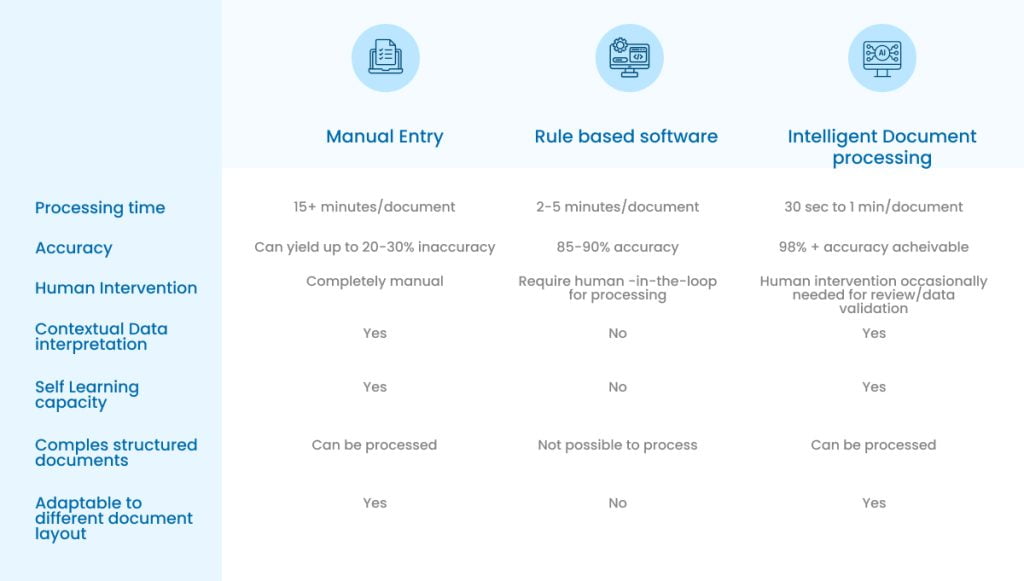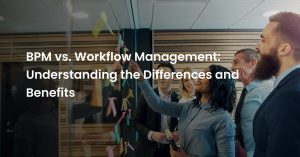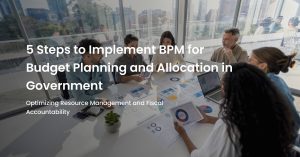
Intelligent Document Processing (IDP) is a transformative technology that streamlines data extraction from various documents and sources. Its primary objective is to seamlessly integrate with core business processes, significantly reduce manual labor, address the intricacies of diverse document layouts, and ensure compliance with legal requirements.
In the realm of any organization, accurate data is paramount. Intelligent document processing plays a pivotal role in managing the complexities associated with processing vast volumes of documents, leading to the automation of manual data entry processes and the departure from traditional semi-automated optical character recognition (OCR) workflows.
In this blog, we will delve into what exactly intelligent document processing entails and explore its diverse use cases across different industries. It is a critical tool for businesses looking to optimize their document processing and data extraction efforts. Let us discuss how this technology can provide tailored solutions to the challenges faced in various sectors.
What is Intelligent Document Processing (IDP)?
Intelligent document processing is like the superhero of data extraction from those tricky, semi-structured or unstructured documents. You know, the ones that usually give us a headache! Imagine you’ve got stacks of invoices, contracts, or forms with data all over the place—it’s a mess! IDP steps in to save the day. It’s like your trusty sidekick equipped with the power of artificial intelligence (AI), machine learning (ML), optical character recognition (OCR), computer vision, and intelligent character recognition (ICR).
Here’s the deal: Intelligent document processing doesn’t just stop at extracting data; it transforms it into something organized and useful. It’s often called cognitive data processing or intelligent data capture.
Now, let’s clear up a common misconception. Some folks mix up IDP and OCR (optical character recognition). But that’s not correct! You see, OCR is like the smaller version—a subset of IDP. Intelligent document processing goes above and beyond. It does use OCR for data extraction, but it doesn’t stop there.

IDP brings in the big features: named-entity recognition and classification, supervised and unsupervised learning, and NLP (natural language processing) context analysis. It’s like having a superhero team working together to make sure the data you extract is not just accurate but supercharged with intelligence.
So, when you’re dealing with those complicated, non-standard documents, think of intelligent document processing as your secret weapon. It’s all about simplifying your data processing and analysis, keeping things accurate, and saving you from the headaches of dealing with messy documents.
Intelligent document processing Workflow
So, picture this: stacks of paper documents, invoices, reports—all the good old paperwork. They need to be brought into the digital age. That’s where the scanning hardware devices come into play. They’re like the heroes of this story, converting those paper documents into digital formats.
Now, here’s the cool part. The IDP solutions have computer vision algorithms that look at these scanned images, PDFs, and all sorts of files. They’re like digital detectives, figuring out the layout of each document.
But what about the actual text on these pages? That’s where Natural Language Processing (NLP) comes in. It’s like magic for words. It reads text and recognizes characters, letters, numbers—you name it. And it doesn’t just stop there; it understands the context too. It can even tell you about the sentiment behind the words. Plus, it tags and organizes the information neatly with incredible accuracy—over 99%.
Now, let’s break down the key steps in the intelligent document processing workflow:
Step 1: Document Preprocessing: This is where the documents get their digital makeover. First up, we have “Binarization.” It’s a fancy term for turning colourful images into black and white. The idea is to make the text stand out from the background in black and white.
Then comes “Deskewing.” Sometimes when you scan a document, it’s a bit uneven. Not ideal for reading, right? So, with the use of this technique, you can straighten things up.
And “noise removal” is like getting rid of those tiny specks that can confuse the reading process. Think of it as cleaning up the digital image.
Step 2: Document Classification: Document classification encompasses three distinct tasks:
- Identifying Format: determining the format of the document, whether it’s a PDF, JPG, PNG, TIFF, or another file format.
- Identifying Structure: categorizing documents into structured, semi-structured, or unstructured forms Structured documents adhere to a predefined template, while semi-structured documents exhibit some structured elements. In contrast, unstructured documents lack a consistent format.
- Identifying Document Type: Identifying the specific type of document, such as an invoice, bank statement, tax statement, shipping label, and so on. The system’s ability to successfully classify documents is contingent upon the data available in the Intelligent Document Processing solution.
Step 3: Data Extraction: Data extraction encompasses two primary aspects:
- Key-Value Pair Extraction: This process involves extracting values associated with unique key identifiers within documents.
- Table Extraction: It involves extracting line items presented in a tabular format.
Data extraction is achieved through multiple methods:
- OCR: This marks the initial stage of data extraction. However, OCR can be prone to errors, such as misinterpreting text blocks due to poor image quality. These errors can be addressed through dictionary look-up and language models, including k-Mer and n-gram models.
- Rule-Based Extraction: Suitable for structured and semi-structured documents, this method identifies key-value pairs and line items based on positional references.
- Learning-Based Approach: Employing deep learning and machine learning, this approach involves supervised and unsupervised learning to enhance the accuracy and confidence of data extraction models. With consistent exposure to documents and continuous feedback, these models continually improve.
Step 4: Data Validation: This step is critical for identifying inaccuracies in the extracted data. Data validation rules are applied to detect discrepancies. For instance, the “total amount payable” on an invoice must align with the sum of the “subtotal” and “tax payable.” Any disparities lead to the document being flagged for review.
Step 5: Human Review: Recognizing that no data extraction model can achieve 100% accuracy, a human review element is introduced into the workflow. Documents flagged as requiring attention are assessed by human reviewers. This iterative process significantly contributes to refining the accuracy of the data extraction model. Once the data is extracted and cleaned up, the software can push to the database or export it in multiple formats. IDP workflows let users convert documents into different formats such as JSON, XML, PDF, etc.
Intelligent Document Processing Use-cases (by capability)
Deciphering the Unreadable: First up, IDP can work wonders when it comes to handling those not-so-great documents. You know, the ones with substandard quality that traditional OCR software throws a fit over. With AI-driven Intelligent document processing, we’re talking about reading even the messiest of documents and, to get this, understanding the context. It’s like IDP can tell you, “This word here matters, and that one, not so much.” Traditional OCR? Not so much.
Barcode and QR Code expertise: Now, Intelligent document processing is not just about reading text. It’s also about handling those cryptic barcodes and QR codes. Need to process them? No problem. IDP’s got your back.
Auto-Classification, the Smart Sorter: You ever dealt with a stack of documents from various sources, in all shapes and sizes? IDP doesn’t break a sweat. It’s like having a personal assistant that can magically sort documents into neat little categories. It’s like, “This goes here, and that goes there.” Super-efficient.
Extracting the Golden Nuggets: IDP isn’t just about sorting; it’s also about mining for gold. Need specific information from a document? IDP can be trained to dig that up for you. No more hunting through piles of papers.
The Validator of Truth: It’s not just about extracting data; it’s about making sure it’s right. Intelligent document processing double-checks against the rules you set. If something seems off, it raises a flag for manual review. It’s like having a built-in fact-checker.
Master Organizer: Say goodbye to the chaos of multiple documents from different sources. IDP is like your personal organizer. It takes data from here, there, and everywhere, and neatly puts it in one place for you. No more hunting through folders.
Industry-Specific Intelligent Document Processing Use Cases
1. Lending Industry: Picture this – you’re applying for a loan, whether it’s for your dream home, your business expansion, or any other financial need. Now, IDP comes into play. It’s like having a super-efficient assistant for lenders. They use Intelligent document processing to process your loan applications, but here’s the kicker – it eliminates all that tedious manual data entry. So, you get faster responses, and lenders have more time to carefully analyze your creditworthiness.
But wait, there’s more! If you’re getting a mortgage, IDP is your unsung hero. It checks and double-checks your data, credit reports, IDs, and income documents. It ensures your mortgage journey is smoother than ever.
2. Insurance: Insurance companies swim in a sea of customer data. IDP helps them stay afloat and make sense of it all. When you apply for insurance, IDP plays its part in figuring out the risk factor based on your data. The result? You get better premium rates and perks. It’s all about finding the sweet spot between risk and reward.
3. Logistics: In the world of logistics, documents are like currency. They flow through shipping, warehousing, and delivery like a busy marketplace. Intelligent document processing steps in as the efficient cashier. It reads invoices, labels, and agreements. No need for manual processing, which is a time-saver, right? Plus, as businesses grow, IDP grows with them, scaling up their document-processing game.
4. Commercial Real Estate: Imagine you’re a commercial property owner or investor. IDP becomes your research assistant. It dives into the nitty-gritty of rent rolls, lease agreements, and market rates. With its insights, you can confidently decide whether a property is a worthwhile investment. When you’re buying, IDP helps you figure out if the deal matches the market rates. It’s like having a crystal ball for real estate investments.
5. Accounts Payable: Now, let’s talk about the accounting world. Invoices come in all shapes and sizes, right? Intelligent document processing makes sense of this chaotic invoice jungle. It’s like an expert puzzle solver. It reads invoices with different formats, matches them against purchase orders, and does it all in real-time. This makes life easier for accounting professionals and their clients. No more headaches over invoice formats and matching.
Advantages of Intelligent Document Processing
Imagine a world where all those tiresome, manual tasks that you dread – gone in a flash. That’s the magic of Intelligent Document Processing (IDP). It’s like the superhero of automation, converting chaotic data into something understandable and ready to lock in various applications and systems.
Now, you’re probably wondering, “What’s in it for me?” Well, buckle up, because IDP comes with its advantages:
1. Faster Document Handling: Say goodbye to slow data extraction. With AI-native intelligent document processing solutions, you can turbocharge your data extraction speed by up to 10 times. It’s like hitting the fast-forward button for your work.
2. Top-Notch Accuracy: We’re talking precision here. IDP can achieve data extraction accuracy rates of up to 99.9% for different document types, and that’s with a whopping 95%+ straight-through processing. No more sweating over mistakes.
3. Productivity Boost: With IDP in your corner, your team can breathe easily. It slashes processing time and ushers in a new era of straight-through processing, which means your employees don’t have to wrestle with unstructured text or do manual data entry. Productivity just skyrocketed.
4. Paperless Functioning: Ready to kiss paper goodbye? IDP makes it happen. No more rummaging through stacks of paper. It’s all digital, making data sharing a breeze and getting you on the digital transformation train.
5. Cost-Efficient: Picture this: no more manual data entry, no more human bloopers, and no more manual reviews. Combine all that with speedy and accurate document processing, and you’re looking at savings that can reach up to 70%. It’s practically money in the bank.
6. Business-Level Automation: Integration is the name of the game, and IDP plays it well. It seamlessly teams up with your existing systems. Couple that with other automation solutions, and you’ve got a fully integrated RPA (Robotic Process Automation) system – it’s like building your very own automation dream team.
Different Types of Intelligent Document Processing Vendors
We’ve divided IDP vendors into 4 categories –
1. Innovative IDP Vendors: Picture this category as the pioneers of the IDP frontier. These are the forward-thinkers who’ve crafted AI-native platforms to work their magic on document processing. What’s their superpower? They can handle complex and diverse documents with precision, thanks to their AI-centered approach. The result? An end-to-end document processing solution that’s incredibly efficient and often needs minimal human intervention. A few noteworthy players here are Hyperscience, Rossum, and Infrrd.
2. Legacy IDP Vendors: Now, on the flip side, we have the Legacy IDP Vendors. They might not be the AI trailblazers, but they bring their own strengths to the game. These folks have a solid foundation in OCR (Optical Character Recognition) and RPA (Robotic Process Automation). Their sweet spot? Handling bulk documents that can be neatly templated and follow straightforward layouts. Plus, they often offer a broader range of automation solutions. Names that come to mind include Abbyy, Kofax, AntWorks, and Automation Anywhere.
3. Niche IDP Vendors: If you’re seeking specialists who dive deep into specific challenges, say hello to Niche IDP Vendors. They’re like precision surgeons of document processing. Focused on solving a narrow set of problems, these folks cater to industries. The result? Swift, reliable, and super-efficient solutions tailored to the industry’s unique needs. Notable names are EvolutionAI, Instabase, Ocrolus, and ClickAI.
4. IDP Components Technology Providers: Now, imagine a category that doesn’t hand you the whole solution but rather equips you with the tools to build your own. That’s where the IDP Components Technology Providers come in. They supply you with versatile tech components such as OCR and computer vision. You’ll need a squad of IT pros and data scientists to cook up a customized solution for your business using these components. Companies like Google Cloud Vision, Amazon Textract, and Microsoft Azure Computer Vision are your go-to tech buddies here.
Intelligent Document Processing Solutions by SquareOne
At SquareOne, we’re more than just a service provider; we’re your partners in simplifying complex document processes. Our IDP solutions are designed to streamline your operations, save you time, and reduce errors. Our solution helps businesses with –
- Invoices and bank statements processing
- Simplifying data extraction from income and identity verification documents
- Automated data extraction for IRS Forms
- Non-standard lease agreements, sales comps, and offering memorandum data processing
- Processing bill of lading/shipping labels/receipts
Trust SquareOne to make document management a breeze and elevate your business efficiency. Your documents, our expertise—a partnership that delivers results
Get started with SquareOne today and experience the future of intelligent document processing.
















